Atten Babler Corn & Soybeans FX Indices – Feb…
Corn FX Indices:
The Atten Babler Commodities Corn Foreign Exchange (FX) Indices continued to strengthen throughout Jan ’17, each finishing at record high levels. The USD/Corn Importer FX Index increased the most throughout the month, followed by the USD/Domestic Corn Importer FX Index and the USD/Corn Exporter FX Index.
Global Corn Net Trade:
Major net corn exporters are led by the U.S., followed by Brazil, Ukraine, Argentina, Russia and India (represented in green in the chart below). Major net corn importers are led by the EU-28, followed by Japan, Mexico, South Korea, Egypt and Iran (represented in red in the chart below).
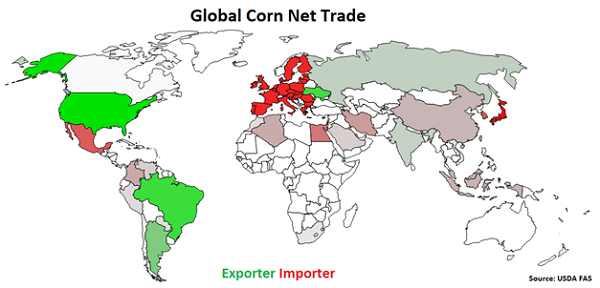 The United States accounts for over two fifths of the USD/Corn Exporter FX Index, followed by Brazil at 18%, Ukraine at 16% and Argentina at 10%.
The United States accounts for over two fifths of the USD/Corn Exporter FX Index, followed by Brazil at 18%, Ukraine at 16% and Argentina at 10%.
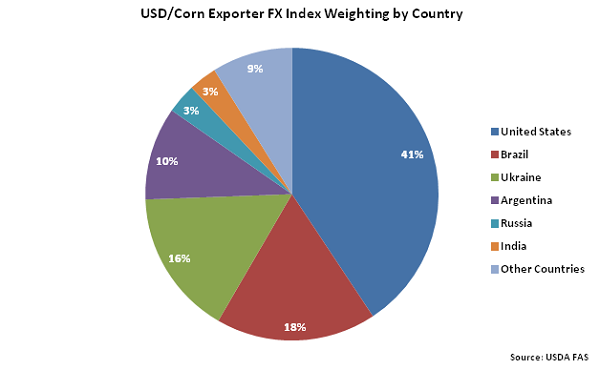 The EU-28 and Japan each account for 14% of the USD/Corn Importer FX Index. Mexico, South Korea, Egypt and Iran each account for between 5-10% of the index.
The EU-28 and Japan each account for 14% of the USD/Corn Importer FX Index. Mexico, South Korea, Egypt and Iran each account for between 5-10% of the index.
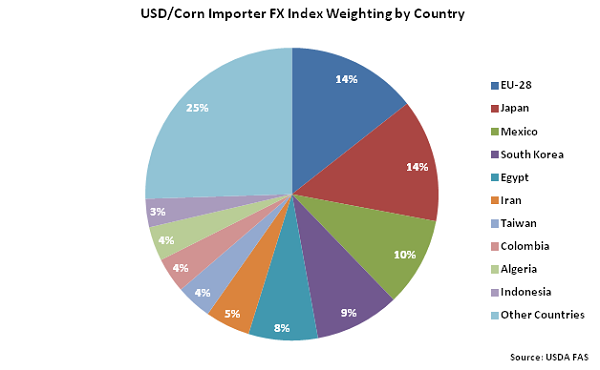 USD/Corn Exporter FX Index:
The USD/Corn Exporter FX Index increased 1.1 points during Jan ’17, finishing at a record high value of 254.0. The USD/Corn Exporter FX Index has increased 17.0 points over the past six months and 173.3 points since the beginning of 2014. A strong USD/Corn Exporter FX Index reduces the competitiveness of U.S. corn relative to other exporting regions (represented in green in the Global Corn Net Trade chart), ultimately resulting in less foreign demand, all other factors being equal. USD appreciation against the Argentine peso has accounted for the majority of the gains since the beginning of 2014.
USD/Corn Exporter FX Index:
The USD/Corn Exporter FX Index increased 1.1 points during Jan ’17, finishing at a record high value of 254.0. The USD/Corn Exporter FX Index has increased 17.0 points over the past six months and 173.3 points since the beginning of 2014. A strong USD/Corn Exporter FX Index reduces the competitiveness of U.S. corn relative to other exporting regions (represented in green in the Global Corn Net Trade chart), ultimately resulting in less foreign demand, all other factors being equal. USD appreciation against the Argentine peso has accounted for the majority of the gains since the beginning of 2014.
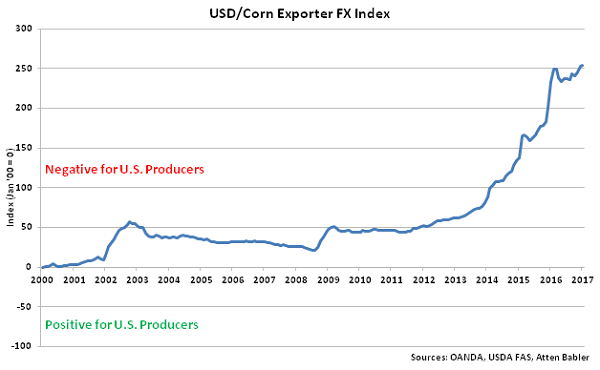 USD appreciation within the USD/Corn Exporter FX Index during Jan ’17 was led by gains against the Ukrainian hryvnia, followed by USD appreciation against the Argentine peso. USD declines were exhibited against the South African rand, Russian ruble and Brazilian real.
USD appreciation within the USD/Corn Exporter FX Index during Jan ’17 was led by gains against the Ukrainian hryvnia, followed by USD appreciation against the Argentine peso. USD declines were exhibited against the South African rand, Russian ruble and Brazilian real.
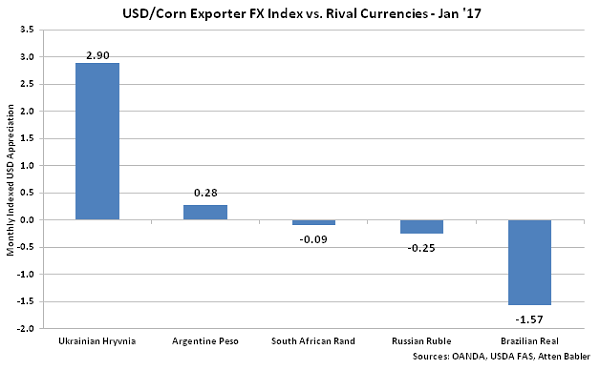 USD/Corn Importer FX Index:
The USD/Corn Importer FX Index increased 6.0 points during Jan ’17, finishing at a record high value of 180.0. The USD/Corn Importer FX Index has increased 33.9 points throughout the past six months and 83.3 points since the beginning of 2014. A strong USD/Corn Importer FX Index results in less purchasing power for major corn importing countries (represented in red in the Global Corn Net Trade chart), making U.S. corn more expensive to import. USD appreciation against the Egyptian pound and Iranian rial has accounted for the majority of the gains since the beginning of 2014.
USD/Corn Importer FX Index:
The USD/Corn Importer FX Index increased 6.0 points during Jan ’17, finishing at a record high value of 180.0. The USD/Corn Importer FX Index has increased 33.9 points throughout the past six months and 83.3 points since the beginning of 2014. A strong USD/Corn Importer FX Index results in less purchasing power for major corn importing countries (represented in red in the Global Corn Net Trade chart), making U.S. corn more expensive to import. USD appreciation against the Egyptian pound and Iranian rial has accounted for the majority of the gains since the beginning of 2014.
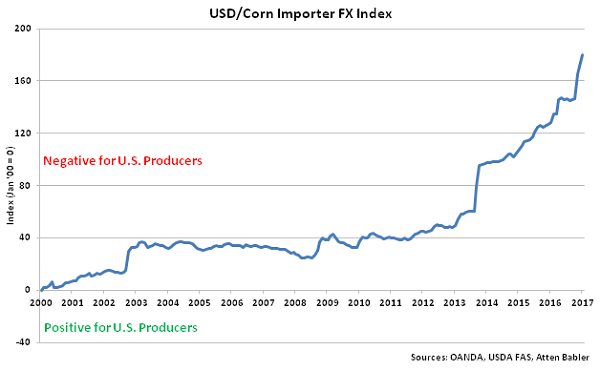 USD appreciation within the USD/Corn Importer FX Index during Jan ’17 was led by gains against the Iranian rial, followed by USD appreciation against the Mexican peso, Turkish lira and Egyptian pound. USD declines were exhibited against the Columbian peso.
USD appreciation within the USD/Corn Importer FX Index during Jan ’17 was led by gains against the Iranian rial, followed by USD appreciation against the Mexican peso, Turkish lira and Egyptian pound. USD declines were exhibited against the Columbian peso.
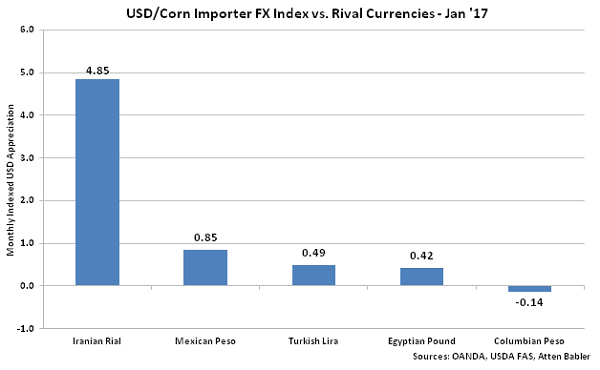 U.S. Corn Export Destinations:
Major destinations for U.S. corn are led by Japan, followed by Mexico, South Korea, Columbia, Egypt and China.
U.S. Corn Export Destinations:
Major destinations for U.S. corn are led by Japan, followed by Mexico, South Korea, Columbia, Egypt and China.
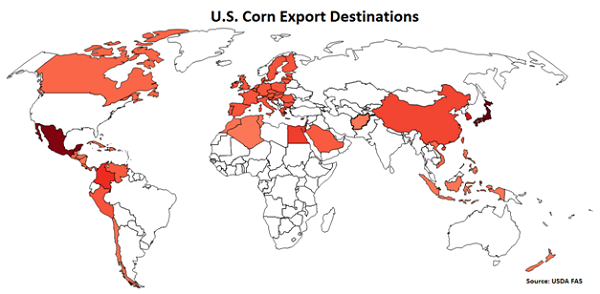 Japan accounts for 27% of the USD/Domestic Corn Importer FX Index, followed by Mexico at 24% and South Korea at 12%. Columbia, Egypt and China each account for between 5-10% of the index.
Japan accounts for 27% of the USD/Domestic Corn Importer FX Index, followed by Mexico at 24% and South Korea at 12%. Columbia, Egypt and China each account for between 5-10% of the index.
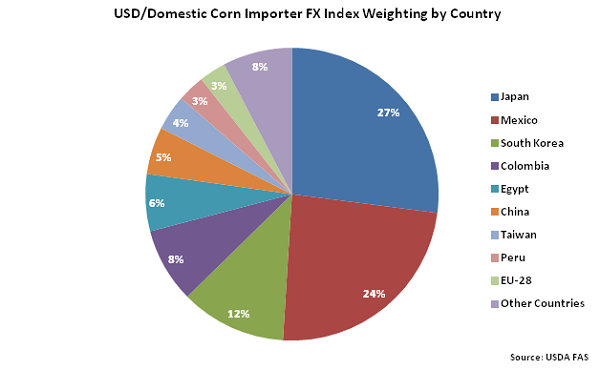 USD/Domestic Corn Importer FX Index:
The USD/Domestic Corn Importer FX Index increased 1.7 points during Jan ’17, finishing at a record high value of 95.6. The USD/Domestic Corn Importer FX Index has increased 28.4 points throughout the past six months and 65.0 points since the beginning of 2014. A strong USD/Domestic Corn Importer FX Index results in less purchasing power for the traditional buyers of U.S. corn (represented in red in the U.S. Corn Export Destinations chart), ultimately resulting in less foreign demand, all other factors being equal. USD appreciation against the Egyptian pound and Mexican peso has accounted for the majority of the gains since the beginning of 2014.
USD/Domestic Corn Importer FX Index:
The USD/Domestic Corn Importer FX Index increased 1.7 points during Jan ’17, finishing at a record high value of 95.6. The USD/Domestic Corn Importer FX Index has increased 28.4 points throughout the past six months and 65.0 points since the beginning of 2014. A strong USD/Domestic Corn Importer FX Index results in less purchasing power for the traditional buyers of U.S. corn (represented in red in the U.S. Corn Export Destinations chart), ultimately resulting in less foreign demand, all other factors being equal. USD appreciation against the Egyptian pound and Mexican peso has accounted for the majority of the gains since the beginning of 2014.
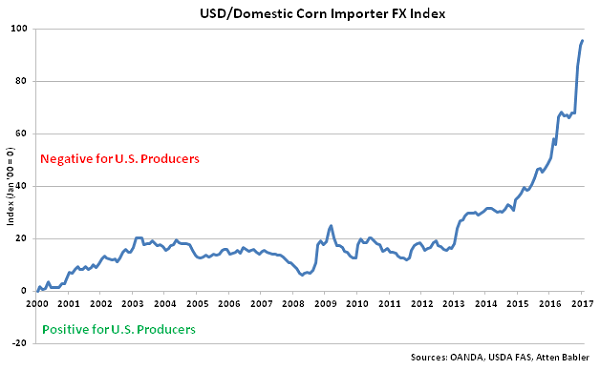 USD appreciation within the USD/Domestic Corn Importer FX Index during Jan ’17 was led by gains against the Mexican peso, followed by USD appreciation against the Egyptian pound. USD declines were exhibited against the Peruvian nuevo sol, Japanese yen and Columbian peso.
USD appreciation within the USD/Domestic Corn Importer FX Index during Jan ’17 was led by gains against the Mexican peso, followed by USD appreciation against the Egyptian pound. USD declines were exhibited against the Peruvian nuevo sol, Japanese yen and Columbian peso.
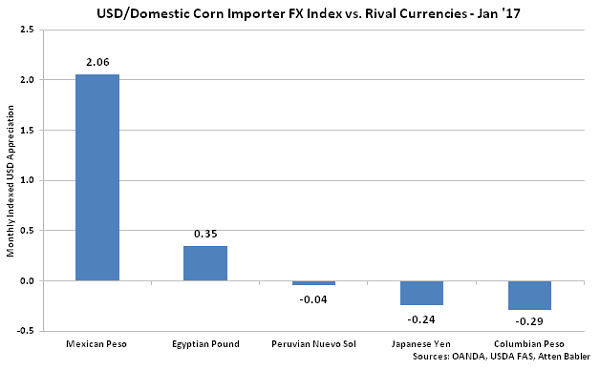 Soybeans FX Indices:
The Atten Babler Commodities Soybeans Foreign Exchange (FX) Indices were mixed throughout Jan ’17. The USD/Soybeans Importer FX Index and USD/Domestic Soybeans Importer FX Index each finished at record high levels throughout the month, however the USD/Soybeans Exporter FX Index declined from the nine month high experienced during the previous month.
Global Soybeans Net Trade:
Major net soybeans exporters are led by Brazil, followed by the U.S., Argentina, Paraguay and Canada (represented in green in the chart below). Major net soybeans importers are led by China, followed by the EU-28, Mexico and Japan (represented in red in the chart below).
Soybeans FX Indices:
The Atten Babler Commodities Soybeans Foreign Exchange (FX) Indices were mixed throughout Jan ’17. The USD/Soybeans Importer FX Index and USD/Domestic Soybeans Importer FX Index each finished at record high levels throughout the month, however the USD/Soybeans Exporter FX Index declined from the nine month high experienced during the previous month.
Global Soybeans Net Trade:
Major net soybeans exporters are led by Brazil, followed by the U.S., Argentina, Paraguay and Canada (represented in green in the chart below). Major net soybeans importers are led by China, followed by the EU-28, Mexico and Japan (represented in red in the chart below).
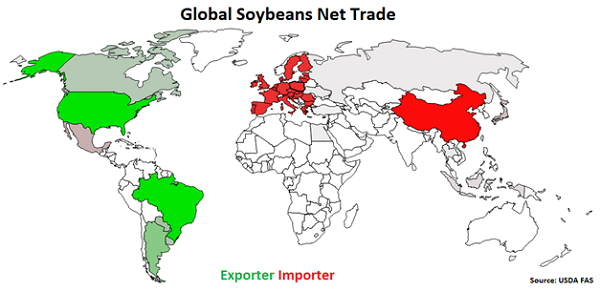 Brazil and the United States each account for over two fifths of the USD/Soybeans Exporter FX Index, followed by Argentina at 7%.
Brazil and the United States each account for over two fifths of the USD/Soybeans Exporter FX Index, followed by Argentina at 7%.
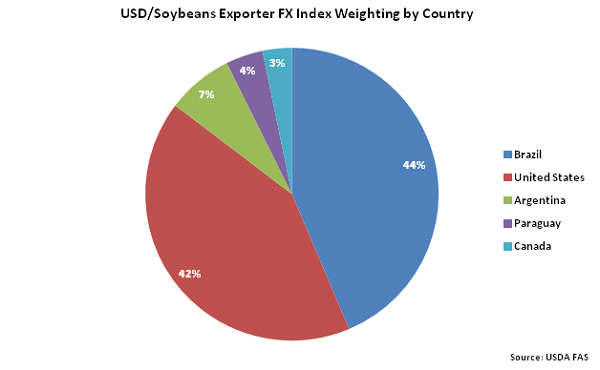 China accounts for nearly two thirds of the USD/Soybeans Importer FX Index, followed by the EU-28 at 12%.
China accounts for nearly two thirds of the USD/Soybeans Importer FX Index, followed by the EU-28 at 12%.
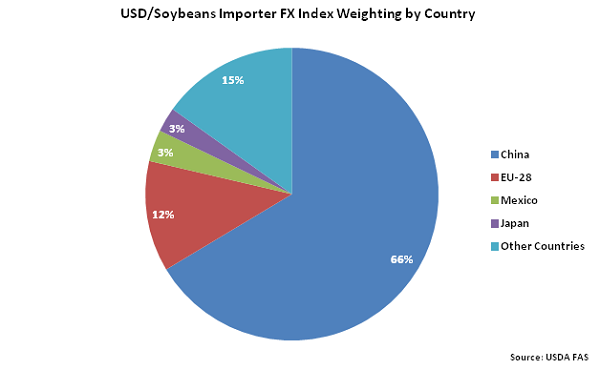 USD/Soybeans Exporter FX Index:
The USD/Soybeans Exporter FX Index declined 3.8 points during Jan ’17, finishing at a value of 145.5. The USD/Soybeans Exporter FX Index remains up 5.8 points throughout the past six months and 92.9 points since the beginning of 2014, despite the most recent decline. A strong USD/Soybeans Exporter FX Index reduces the competitiveness of U.S. soybeans relative to other exporting regions (represented in green in the Global Soybeans Net Trade chart), ultimately resulting in less foreign demand, all other factors being equal. USD appreciation against the Argentine peso has accounted for the majority of the gains since the beginning of 2014.
USD/Soybeans Exporter FX Index:
The USD/Soybeans Exporter FX Index declined 3.8 points during Jan ’17, finishing at a value of 145.5. The USD/Soybeans Exporter FX Index remains up 5.8 points throughout the past six months and 92.9 points since the beginning of 2014, despite the most recent decline. A strong USD/Soybeans Exporter FX Index reduces the competitiveness of U.S. soybeans relative to other exporting regions (represented in green in the Global Soybeans Net Trade chart), ultimately resulting in less foreign demand, all other factors being equal. USD appreciation against the Argentine peso has accounted for the majority of the gains since the beginning of 2014.
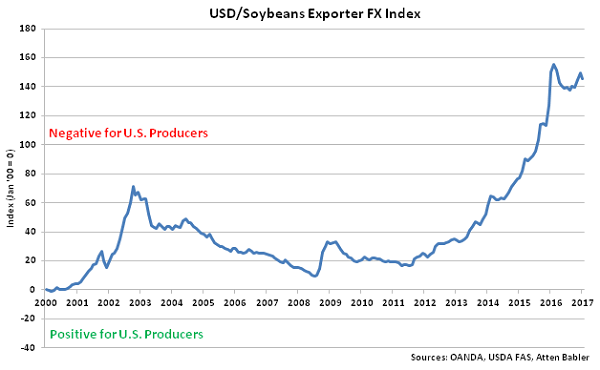 Appreciation against the USD within the USD/Soybeans Exporter FX Index during Jan ’17 was led by gains by the Brazilian real, followed by gains by the Paraguayan guarani and Canadian dollar. USD gains were exhibited against the Argentine peso.
Appreciation against the USD within the USD/Soybeans Exporter FX Index during Jan ’17 was led by gains by the Brazilian real, followed by gains by the Paraguayan guarani and Canadian dollar. USD gains were exhibited against the Argentine peso.
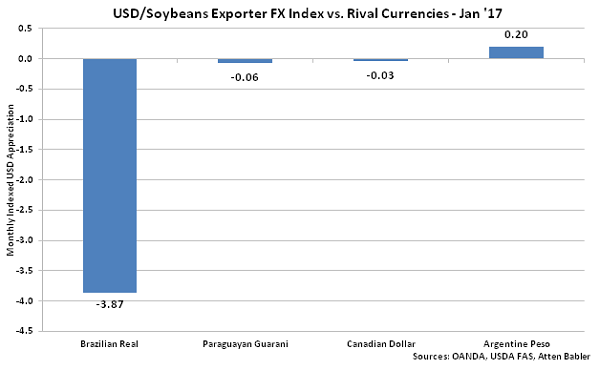 USD/Soybeans Importer FX Index:
The USD/Soybeans Importer FX Index increased 30.5 points during Jan ’17, finishing at a record high value of 12.8. The USD/Soybeans Importer FX Index has increased 10.0 points throughout the past six months and 25.1 points since the beginning of 2014. A strong USD/Soybeans Importer FX Index results in less purchasing power for major soybeans importing countries (represented in red in the Global Soybeans Net Trade chart), making U.S. soybeans more expensive to import. USD appreciation against the Chinese yuan renminbi, Egyptian pound and Turkish lira has accounted for the majority of the gains since the beginning of 2014.
USD/Soybeans Importer FX Index:
The USD/Soybeans Importer FX Index increased 30.5 points during Jan ’17, finishing at a record high value of 12.8. The USD/Soybeans Importer FX Index has increased 10.0 points throughout the past six months and 25.1 points since the beginning of 2014. A strong USD/Soybeans Importer FX Index results in less purchasing power for major soybeans importing countries (represented in red in the Global Soybeans Net Trade chart), making U.S. soybeans more expensive to import. USD appreciation against the Chinese yuan renminbi, Egyptian pound and Turkish lira has accounted for the majority of the gains since the beginning of 2014.
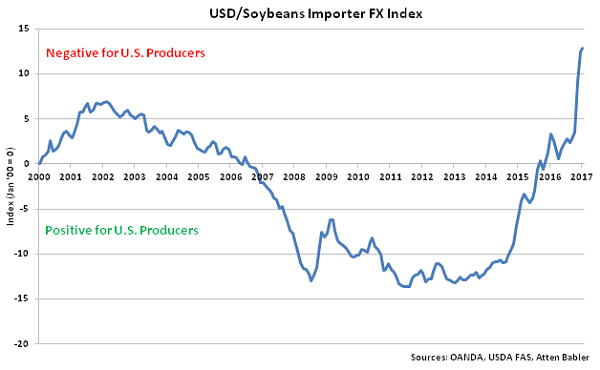 USD appreciation within the USD/Soybeans Importer FX Index during Jan ’17 was led by gains against the Turkish lira, followed by USD appreciation against the Mexican peso. USD declines were exhibited against the euro, Russian ruble and Chinese yuan renminbi.
USD appreciation within the USD/Soybeans Importer FX Index during Jan ’17 was led by gains against the Turkish lira, followed by USD appreciation against the Mexican peso. USD declines were exhibited against the euro, Russian ruble and Chinese yuan renminbi.
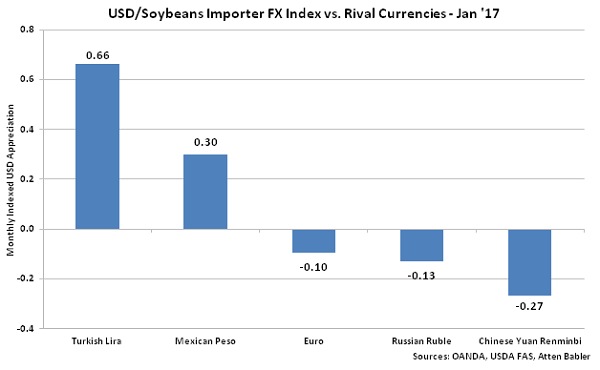 U.S. Soybeans Export Destinations:
Major destinations for U.S. soybeans are led by China, followed by Mexico, Indonesia and Japan.
U.S. Soybeans Export Destinations:
Major destinations for U.S. soybeans are led by China, followed by Mexico, Indonesia and Japan.
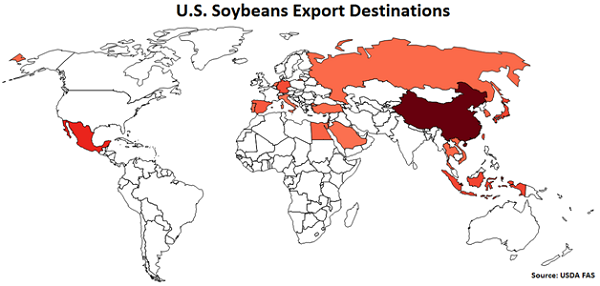 China accounts for nearly two thirds of the USD/Domestic Soybeans Importer FX Index. Mexico, Indonesia and Japan each account for between 5-10% of the index.
China accounts for nearly two thirds of the USD/Domestic Soybeans Importer FX Index. Mexico, Indonesia and Japan each account for between 5-10% of the index.
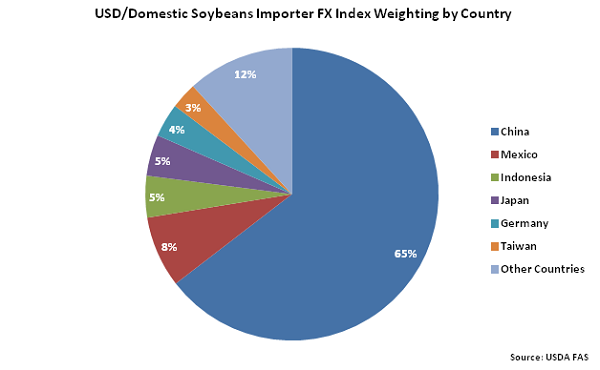 USD/Domestic Soybeans Importer FX Index:
The USD/Domestic Soybeans Importer FX Index increased 0.6 points during Jan ’17, finishing at a record high value of 15.6. The USD/Domestic Soybeans Importer FX Index has increased 10.3 points throughout the past six months and 25.5 points since the beginning of 2014. A strong USD/Domestic Soybeans Importer FX Index results in less purchasing power for the traditional buyers of U.S. soybeans (represented in red in the U.S. Soybeans Export Destinations chart), ultimately resulting in less foreign demand, all other factors being equal. USD appreciation against the Mexican peso and Chinese yuan renminbi has accounted for the majority of the gains since the beginning of 2014.
USD/Domestic Soybeans Importer FX Index:
The USD/Domestic Soybeans Importer FX Index increased 0.6 points during Jan ’17, finishing at a record high value of 15.6. The USD/Domestic Soybeans Importer FX Index has increased 10.3 points throughout the past six months and 25.5 points since the beginning of 2014. A strong USD/Domestic Soybeans Importer FX Index results in less purchasing power for the traditional buyers of U.S. soybeans (represented in red in the U.S. Soybeans Export Destinations chart), ultimately resulting in less foreign demand, all other factors being equal. USD appreciation against the Mexican peso and Chinese yuan renminbi has accounted for the majority of the gains since the beginning of 2014.
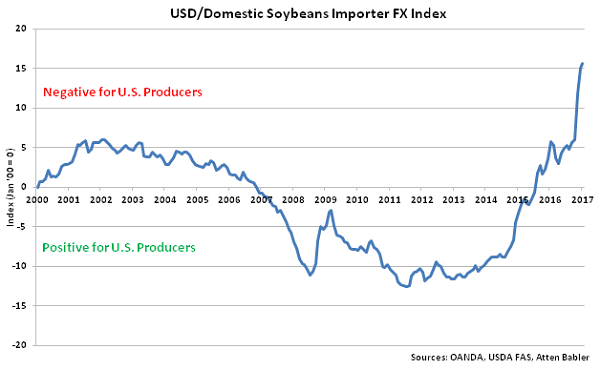 USD appreciation within the USD/Domestic Soybeans Importer FX Index during Jan ’17 was led by gains against the Mexican peso, followed by USD appreciation against the Turkish lira and Egyptian pound. USD declines were exhibited against the Russian ruble and Chinese yuan renminbi.
USD appreciation within the USD/Domestic Soybeans Importer FX Index during Jan ’17 was led by gains against the Mexican peso, followed by USD appreciation against the Turkish lira and Egyptian pound. USD declines were exhibited against the Russian ruble and Chinese yuan renminbi.
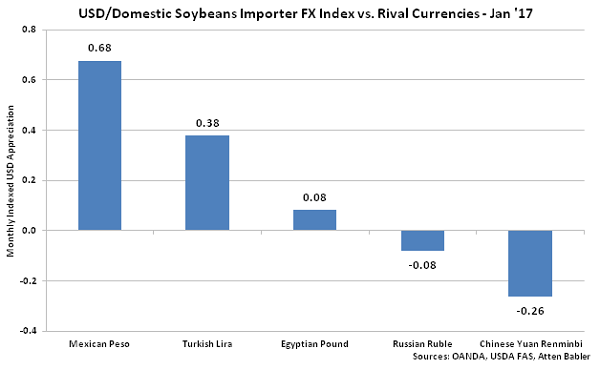
 The United States accounts for over two fifths of the USD/Corn Exporter FX Index, followed by Brazil at 18%, Ukraine at 16% and Argentina at 10%.
The United States accounts for over two fifths of the USD/Corn Exporter FX Index, followed by Brazil at 18%, Ukraine at 16% and Argentina at 10%.
 The EU-28 and Japan each account for 14% of the USD/Corn Importer FX Index. Mexico, South Korea, Egypt and Iran each account for between 5-10% of the index.
The EU-28 and Japan each account for 14% of the USD/Corn Importer FX Index. Mexico, South Korea, Egypt and Iran each account for between 5-10% of the index.
 USD/Corn Exporter FX Index:
The USD/Corn Exporter FX Index increased 1.1 points during Jan ’17, finishing at a record high value of 254.0. The USD/Corn Exporter FX Index has increased 17.0 points over the past six months and 173.3 points since the beginning of 2014. A strong USD/Corn Exporter FX Index reduces the competitiveness of U.S. corn relative to other exporting regions (represented in green in the Global Corn Net Trade chart), ultimately resulting in less foreign demand, all other factors being equal. USD appreciation against the Argentine peso has accounted for the majority of the gains since the beginning of 2014.
USD/Corn Exporter FX Index:
The USD/Corn Exporter FX Index increased 1.1 points during Jan ’17, finishing at a record high value of 254.0. The USD/Corn Exporter FX Index has increased 17.0 points over the past six months and 173.3 points since the beginning of 2014. A strong USD/Corn Exporter FX Index reduces the competitiveness of U.S. corn relative to other exporting regions (represented in green in the Global Corn Net Trade chart), ultimately resulting in less foreign demand, all other factors being equal. USD appreciation against the Argentine peso has accounted for the majority of the gains since the beginning of 2014.
 USD appreciation within the USD/Corn Exporter FX Index during Jan ’17 was led by gains against the Ukrainian hryvnia, followed by USD appreciation against the Argentine peso. USD declines were exhibited against the South African rand, Russian ruble and Brazilian real.
USD appreciation within the USD/Corn Exporter FX Index during Jan ’17 was led by gains against the Ukrainian hryvnia, followed by USD appreciation against the Argentine peso. USD declines were exhibited against the South African rand, Russian ruble and Brazilian real.
 USD/Corn Importer FX Index:
The USD/Corn Importer FX Index increased 6.0 points during Jan ’17, finishing at a record high value of 180.0. The USD/Corn Importer FX Index has increased 33.9 points throughout the past six months and 83.3 points since the beginning of 2014. A strong USD/Corn Importer FX Index results in less purchasing power for major corn importing countries (represented in red in the Global Corn Net Trade chart), making U.S. corn more expensive to import. USD appreciation against the Egyptian pound and Iranian rial has accounted for the majority of the gains since the beginning of 2014.
USD/Corn Importer FX Index:
The USD/Corn Importer FX Index increased 6.0 points during Jan ’17, finishing at a record high value of 180.0. The USD/Corn Importer FX Index has increased 33.9 points throughout the past six months and 83.3 points since the beginning of 2014. A strong USD/Corn Importer FX Index results in less purchasing power for major corn importing countries (represented in red in the Global Corn Net Trade chart), making U.S. corn more expensive to import. USD appreciation against the Egyptian pound and Iranian rial has accounted for the majority of the gains since the beginning of 2014.
 USD appreciation within the USD/Corn Importer FX Index during Jan ’17 was led by gains against the Iranian rial, followed by USD appreciation against the Mexican peso, Turkish lira and Egyptian pound. USD declines were exhibited against the Columbian peso.
USD appreciation within the USD/Corn Importer FX Index during Jan ’17 was led by gains against the Iranian rial, followed by USD appreciation against the Mexican peso, Turkish lira and Egyptian pound. USD declines were exhibited against the Columbian peso.
 U.S. Corn Export Destinations:
Major destinations for U.S. corn are led by Japan, followed by Mexico, South Korea, Columbia, Egypt and China.
U.S. Corn Export Destinations:
Major destinations for U.S. corn are led by Japan, followed by Mexico, South Korea, Columbia, Egypt and China.
 Japan accounts for 27% of the USD/Domestic Corn Importer FX Index, followed by Mexico at 24% and South Korea at 12%. Columbia, Egypt and China each account for between 5-10% of the index.
Japan accounts for 27% of the USD/Domestic Corn Importer FX Index, followed by Mexico at 24% and South Korea at 12%. Columbia, Egypt and China each account for between 5-10% of the index.
 USD/Domestic Corn Importer FX Index:
The USD/Domestic Corn Importer FX Index increased 1.7 points during Jan ’17, finishing at a record high value of 95.6. The USD/Domestic Corn Importer FX Index has increased 28.4 points throughout the past six months and 65.0 points since the beginning of 2014. A strong USD/Domestic Corn Importer FX Index results in less purchasing power for the traditional buyers of U.S. corn (represented in red in the U.S. Corn Export Destinations chart), ultimately resulting in less foreign demand, all other factors being equal. USD appreciation against the Egyptian pound and Mexican peso has accounted for the majority of the gains since the beginning of 2014.
USD/Domestic Corn Importer FX Index:
The USD/Domestic Corn Importer FX Index increased 1.7 points during Jan ’17, finishing at a record high value of 95.6. The USD/Domestic Corn Importer FX Index has increased 28.4 points throughout the past six months and 65.0 points since the beginning of 2014. A strong USD/Domestic Corn Importer FX Index results in less purchasing power for the traditional buyers of U.S. corn (represented in red in the U.S. Corn Export Destinations chart), ultimately resulting in less foreign demand, all other factors being equal. USD appreciation against the Egyptian pound and Mexican peso has accounted for the majority of the gains since the beginning of 2014.
 USD appreciation within the USD/Domestic Corn Importer FX Index during Jan ’17 was led by gains against the Mexican peso, followed by USD appreciation against the Egyptian pound. USD declines were exhibited against the Peruvian nuevo sol, Japanese yen and Columbian peso.
USD appreciation within the USD/Domestic Corn Importer FX Index during Jan ’17 was led by gains against the Mexican peso, followed by USD appreciation against the Egyptian pound. USD declines were exhibited against the Peruvian nuevo sol, Japanese yen and Columbian peso.
 Soybeans FX Indices:
The Atten Babler Commodities Soybeans Foreign Exchange (FX) Indices were mixed throughout Jan ’17. The USD/Soybeans Importer FX Index and USD/Domestic Soybeans Importer FX Index each finished at record high levels throughout the month, however the USD/Soybeans Exporter FX Index declined from the nine month high experienced during the previous month.
Global Soybeans Net Trade:
Major net soybeans exporters are led by Brazil, followed by the U.S., Argentina, Paraguay and Canada (represented in green in the chart below). Major net soybeans importers are led by China, followed by the EU-28, Mexico and Japan (represented in red in the chart below).
Soybeans FX Indices:
The Atten Babler Commodities Soybeans Foreign Exchange (FX) Indices were mixed throughout Jan ’17. The USD/Soybeans Importer FX Index and USD/Domestic Soybeans Importer FX Index each finished at record high levels throughout the month, however the USD/Soybeans Exporter FX Index declined from the nine month high experienced during the previous month.
Global Soybeans Net Trade:
Major net soybeans exporters are led by Brazil, followed by the U.S., Argentina, Paraguay and Canada (represented in green in the chart below). Major net soybeans importers are led by China, followed by the EU-28, Mexico and Japan (represented in red in the chart below).
 Brazil and the United States each account for over two fifths of the USD/Soybeans Exporter FX Index, followed by Argentina at 7%.
Brazil and the United States each account for over two fifths of the USD/Soybeans Exporter FX Index, followed by Argentina at 7%.
 China accounts for nearly two thirds of the USD/Soybeans Importer FX Index, followed by the EU-28 at 12%.
China accounts for nearly two thirds of the USD/Soybeans Importer FX Index, followed by the EU-28 at 12%.
 USD/Soybeans Exporter FX Index:
The USD/Soybeans Exporter FX Index declined 3.8 points during Jan ’17, finishing at a value of 145.5. The USD/Soybeans Exporter FX Index remains up 5.8 points throughout the past six months and 92.9 points since the beginning of 2014, despite the most recent decline. A strong USD/Soybeans Exporter FX Index reduces the competitiveness of U.S. soybeans relative to other exporting regions (represented in green in the Global Soybeans Net Trade chart), ultimately resulting in less foreign demand, all other factors being equal. USD appreciation against the Argentine peso has accounted for the majority of the gains since the beginning of 2014.
USD/Soybeans Exporter FX Index:
The USD/Soybeans Exporter FX Index declined 3.8 points during Jan ’17, finishing at a value of 145.5. The USD/Soybeans Exporter FX Index remains up 5.8 points throughout the past six months and 92.9 points since the beginning of 2014, despite the most recent decline. A strong USD/Soybeans Exporter FX Index reduces the competitiveness of U.S. soybeans relative to other exporting regions (represented in green in the Global Soybeans Net Trade chart), ultimately resulting in less foreign demand, all other factors being equal. USD appreciation against the Argentine peso has accounted for the majority of the gains since the beginning of 2014.
 Appreciation against the USD within the USD/Soybeans Exporter FX Index during Jan ’17 was led by gains by the Brazilian real, followed by gains by the Paraguayan guarani and Canadian dollar. USD gains were exhibited against the Argentine peso.
Appreciation against the USD within the USD/Soybeans Exporter FX Index during Jan ’17 was led by gains by the Brazilian real, followed by gains by the Paraguayan guarani and Canadian dollar. USD gains were exhibited against the Argentine peso.
 USD/Soybeans Importer FX Index:
The USD/Soybeans Importer FX Index increased 30.5 points during Jan ’17, finishing at a record high value of 12.8. The USD/Soybeans Importer FX Index has increased 10.0 points throughout the past six months and 25.1 points since the beginning of 2014. A strong USD/Soybeans Importer FX Index results in less purchasing power for major soybeans importing countries (represented in red in the Global Soybeans Net Trade chart), making U.S. soybeans more expensive to import. USD appreciation against the Chinese yuan renminbi, Egyptian pound and Turkish lira has accounted for the majority of the gains since the beginning of 2014.
USD/Soybeans Importer FX Index:
The USD/Soybeans Importer FX Index increased 30.5 points during Jan ’17, finishing at a record high value of 12.8. The USD/Soybeans Importer FX Index has increased 10.0 points throughout the past six months and 25.1 points since the beginning of 2014. A strong USD/Soybeans Importer FX Index results in less purchasing power for major soybeans importing countries (represented in red in the Global Soybeans Net Trade chart), making U.S. soybeans more expensive to import. USD appreciation against the Chinese yuan renminbi, Egyptian pound and Turkish lira has accounted for the majority of the gains since the beginning of 2014.
 USD appreciation within the USD/Soybeans Importer FX Index during Jan ’17 was led by gains against the Turkish lira, followed by USD appreciation against the Mexican peso. USD declines were exhibited against the euro, Russian ruble and Chinese yuan renminbi.
USD appreciation within the USD/Soybeans Importer FX Index during Jan ’17 was led by gains against the Turkish lira, followed by USD appreciation against the Mexican peso. USD declines were exhibited against the euro, Russian ruble and Chinese yuan renminbi.
 U.S. Soybeans Export Destinations:
Major destinations for U.S. soybeans are led by China, followed by Mexico, Indonesia and Japan.
U.S. Soybeans Export Destinations:
Major destinations for U.S. soybeans are led by China, followed by Mexico, Indonesia and Japan.
 China accounts for nearly two thirds of the USD/Domestic Soybeans Importer FX Index. Mexico, Indonesia and Japan each account for between 5-10% of the index.
China accounts for nearly two thirds of the USD/Domestic Soybeans Importer FX Index. Mexico, Indonesia and Japan each account for between 5-10% of the index.
 USD/Domestic Soybeans Importer FX Index:
The USD/Domestic Soybeans Importer FX Index increased 0.6 points during Jan ’17, finishing at a record high value of 15.6. The USD/Domestic Soybeans Importer FX Index has increased 10.3 points throughout the past six months and 25.5 points since the beginning of 2014. A strong USD/Domestic Soybeans Importer FX Index results in less purchasing power for the traditional buyers of U.S. soybeans (represented in red in the U.S. Soybeans Export Destinations chart), ultimately resulting in less foreign demand, all other factors being equal. USD appreciation against the Mexican peso and Chinese yuan renminbi has accounted for the majority of the gains since the beginning of 2014.
USD/Domestic Soybeans Importer FX Index:
The USD/Domestic Soybeans Importer FX Index increased 0.6 points during Jan ’17, finishing at a record high value of 15.6. The USD/Domestic Soybeans Importer FX Index has increased 10.3 points throughout the past six months and 25.5 points since the beginning of 2014. A strong USD/Domestic Soybeans Importer FX Index results in less purchasing power for the traditional buyers of U.S. soybeans (represented in red in the U.S. Soybeans Export Destinations chart), ultimately resulting in less foreign demand, all other factors being equal. USD appreciation against the Mexican peso and Chinese yuan renminbi has accounted for the majority of the gains since the beginning of 2014.
 USD appreciation within the USD/Domestic Soybeans Importer FX Index during Jan ’17 was led by gains against the Mexican peso, followed by USD appreciation against the Turkish lira and Egyptian pound. USD declines were exhibited against the Russian ruble and Chinese yuan renminbi.
USD appreciation within the USD/Domestic Soybeans Importer FX Index during Jan ’17 was led by gains against the Mexican peso, followed by USD appreciation against the Turkish lira and Egyptian pound. USD declines were exhibited against the Russian ruble and Chinese yuan renminbi.
